
Understanding Electric Charge
Electricity is rooted in atomic particles. Electrons carry a negative charge, while protons are positive. Electricity involves the movement of these charges, often through conductive materials, enabling the use of electrical energy.
Voltage: Electric Pressure
Voltage, measured in volts, is the potential difference in charge between two points. It's like water pressure in pipes, pushing electric current (flow of electrons) through a circuit. Higher voltage means more potential to do work.
Current and Its Flow
Electric current, measured in amperes (amps), is the rate of charge flow past a given point. Alternating current (AC) changes direction periodically, while direct current (DC) flows in one direction, each with distinct applications.
Resistance vs Conductivity
Resistance, measured in ohms, opposes current. Conductors have low resistance and allow electrons to flow easily. Insulators resist electron flow. Superconductors, at extremely low temperatures, have zero resistance, allowing lossless energy transmission.
Circuits and Components
Electric circuits connect electrical devices, using wires and components like resistors, capacitors, and inductors, each affecting the circuit in unique ways. Integrated circuits miniaturize components on semiconductor wafers, revolutionizing electronics.Electric Eel Shocks
Electric eels can generate up to 600 volts, enough to stun a horse. This biological phenomenon combines electricity and survival.
What carries a positive charge?
Electrons
Protons
Neutrons
Company